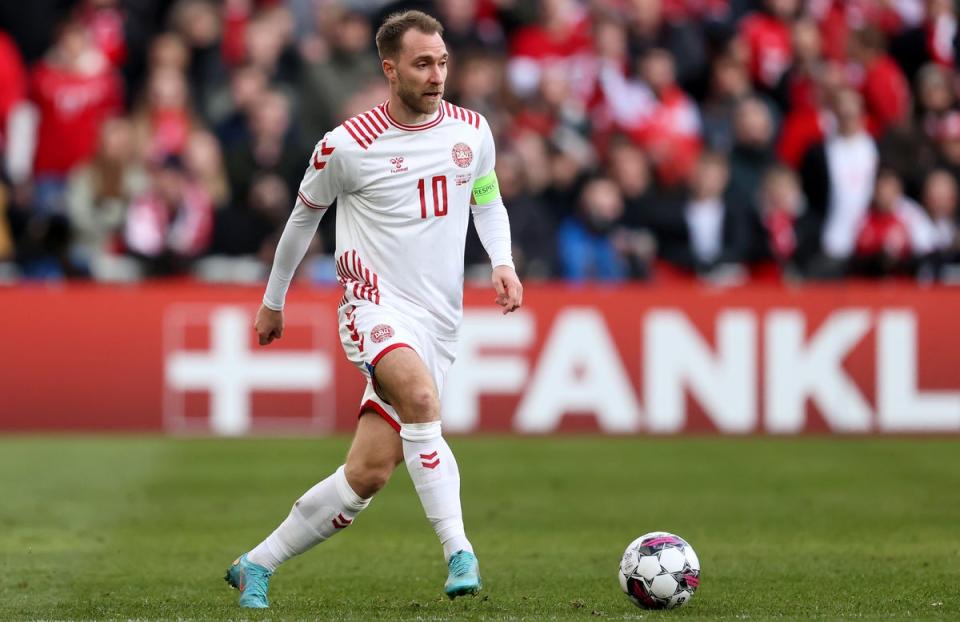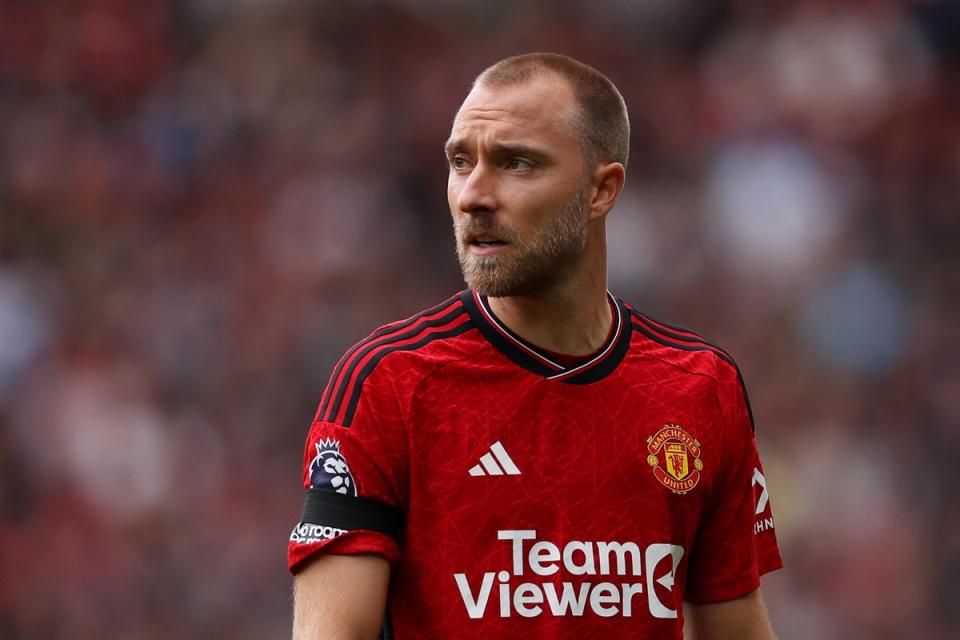For Christian Eriksen, Man United’s trip to Copenhagen is a homecoming with a difference
It is a homecoming with a difference: not to the place where it all started, but to the ground where it almost finished. Christian Eriksen suffered a cardiac arrest on the Parken Stadium pitch at Euro 2020. His life could have ended, yet he is almost two years into a comeback. And it remains remarkable that Eriksen has returned to play for one of the game’s biggest clubs (Manchester United’s recent travails aside), at a World Cup, and in the Champions League.
Eriksen has appeared at the Parken Stadium since, most recently in a 3-1 win over Kazakhstan three weeks ago. Now, once again, Denmark’s national ground will welcome arguably the greatest Danish footballer since Peter Schmeichel and the Laudrup brothers. Also there will be the most-expensive-ever Danish footballer, with the £72m Rasmus Hojlund alongside Eriksen in United’s ranks.
Eriksen might be there from the start this time. Erik ten Hag might have erred in United’s meeting with FC Copenhagen two weeks ago, initially benching Eriksen for a first half where the Danish champions were the more impressive side. But with a practised assurance in possession, a Dane helped his side assume the initiative thereafter.
It seems a relatively safe assumption that Eriksen will start the rematch. And yet his fluctuating status is a sign of United’s midfield conundrum, his strengths and weaknesses indicative of the mismatched and very different options.
It is a simplification to say that those who can run aren’t particularly good with the ball at their feet and those who can excel with the ball aren’t particularly good at running; but perhaps not much of one. The immobility of Eriksen and Casemiro can be an issue: bringing in Hannibal Mejbri or Scott McTominay adds graft, but at the expense of craft. The young Tunisian’s hapless first half against Galatasaray prompted Ten Hag to send for Eriksen as an antidote; a player who could combine the Scot’s athleticism with the Dane’s technical ability may be United’s ideal.
The difficulties may be compounded by Ten Hag’s preference for man-marking in midfield, sometimes submitting a less athletic player to an unfair contest; Eriksen spent the first half of the Manchester derby struggling to track Bernardo Silva.

It may explain why – especially as Casemiro seems to be slowing – he looked to be reinvented as a specialist substitute. And yet, there were three games – against Galatasaray, Brentford and Copenhagen – where Eriksen had to be summoned at half-time to fix a broken midfield; twice United ended up winning, and the defeat by the Turkish side could scarcely be blamed on the Dane, who still made a difference.
Damningly and undiplomatically, Ten Hag said he removed Casemiro for Eriksen against Brentford because he “wanted more football”. And, for a manager who has spent £400m, a 31-year-old free transfer, a player who finds it difficult to play 90 minutes, has a unique skill set: Casemiro and Bruno Fernandes can attempt ambitious passes, but Eriksen is the only genuine playmaker.
When Ten Hag attempted to explain his ethos – and how he was trying to fuse the best of Ajax with United’s traditions and current players – on Friday, it was notable he put Eriksen in a category of his own. McTominay and Fernandes were mentioned along with Marcus Rashford, Antony and Hojlund among players who can press in the final third and benefit from direct attacks. Those qualities were matched “with the passing of Christian Eriksen”, said Ten Hag. Perhaps, had Casemiro been fit rather than out for several weeks, he might have been bracketed alongside his fellow veteran. Instead, it suggested that Eriksen is the lone passer.

The Dutchman’s words can confuse. His deeds are instructive, though. Twice, Eriksen was preferred to Sofyan Amrabat: first when the Morocco international was brought off at the break when Copenhagen visited Old Trafford, then when Eriksen started as the deepest midfielder at Fulham on Saturday. It is a harder strategy to employ when a specialist defensive midfielder is required.
The context suggests Ten Hag’s midfield plans are in ruins. The summer recruitment brought in Mason Mount, scarcely a like-for-like replacement for Eriksen, with the intention of constructing a new trio with Casemiro and Fernandes. It promised a different dynamic: more high pressing, removing one deep-lying distributor.
Go back a year and Eriksen was supplying assists in copious quantities. Results suggested he and Casemiro were well matched: after United lost the first time they started together, they won on 15 of the next 18 occasions.
How United would settle for that kind of record now, with any midfield combination. Instead, they have the sense that, Fernandes apart, there are no automatic choices now – that the heart of the team is in a state of flux. But Eriksen is the midfield’s artist and, as he returns to his homeland, the Danish public can at least savour the sight of the player and the man they almost lost.

